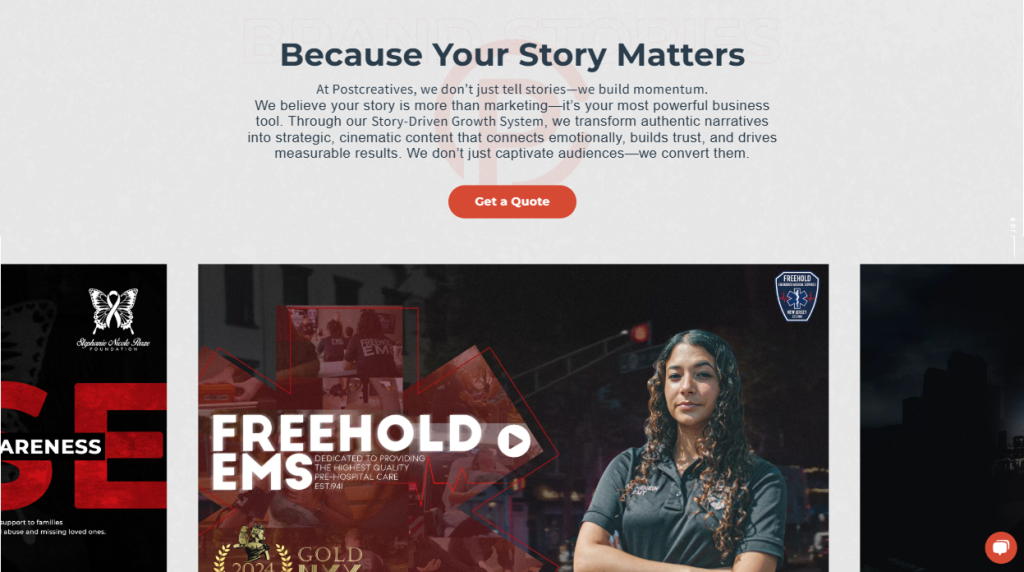In today’s digital-first world, video is no longer optional—it’s the engine of effective marketing. As consumer attention becomes harder to earn (and even harder to keep), businesses that leverage multiple types of video content across their websites and platforms are the ones gaining traction, earning trust, and driving real results.
If your business is still relying on one catch-all video, it’s time to rethink the strategy. The question isn’t “Should we use video?”—it’s “How many strategic videos can we afford not to have?”
At Postcreatives, we help brands deploy video content that’s not only beautiful, but purposeful. Here’s why building a library of tailored, platform-specific videos is now essential to staying relevant—and competitive.
One Format Can’t Do It All: Why You Need More Than One Video
Video Consumption Is Exploding
Consumers are watching more video content than ever—91% of businesses now use video as a marketing tool, up from 63% just five years ago (Wyzowl, 2024). But as viewership increases, so does audience expectation. Your customers don’t just want a video—they want the right video, at the right time, in the right format.
1. Multiply Your Reach with Platform-Specific Videos
Different platforms, different purposes. A product demo on your homepage won’t perform the same on Instagram. A 15-second teaser that works for TikTok won’t convey the full value of your service on YouTube.
By producing a range of content—from short-form brand snippets to detailed explainers and customer testimonials—you can maximize your visibility across every platform your audience uses.
- Instagram: Short-form, brand-building or promotional content
- YouTube: Long-form explainers, tutorials, product stories
- Website: Homepage explainers, testimonials, and product demos
- LinkedIn: Thought leadership, behind-the-scenes, brand stories
- Email: Personalized outreach or post-purchase content
When your message meets your audience where they are, engagement goes up.
2. Video Powers SEO and Visibility
Videos don’t just live on social—they improve your site performance too. Search engines like Google reward content that keeps visitors engaged, and video dramatically increases dwell time, reducing bounce rates.
More videos = more indexed pages, more internal links, more keyword opportunities, and better rankings.
According to Forrester, a page with video is 53x more likely to rank on page one of Google. And thanks to schema markup, well-optimized videos are eligible for rich snippets (i.e., the eye-catching video thumbnails you see in search results).
3. Serve Every Buyer Persona and Stage of the Funnel
Not every viewer is at the same place in their journey—and video lets you meet them where they are.
- Top-of-funnel prospects want to know who you are → Brand video or mission story
- Middle-of-funnel leads want to know how you help → Explainer video or product demo
- Bottom-of-funnel buyers want proof → Customer testimonials, case studies, reviews
Video lets you segment, personalize, and move people through your funnel faster.
4. Build Deeper Relationships with Storytelling
One video might show what you do—but multiple videos show who you are. The most successful brands use video to build familiarity and trust over time. By sharing multiple stories—about your team, your values, your customers—you create a narrative arc that builds credibility and loyalty.
This kind of video strategy doesn’t just support marketing—it supports brand culture. And in a world where consumers are seeking connection, it makes a difference.
5. Videos Convert—Consistently
Video drives action. Landing pages with video convert up to 80% higher, and emails that include video see 19% more opens and 65% more click-throughs (Campaign Monitor).
Each video you publish becomes a sales tool: explaining, persuading, and converting even while you sleep. But one video can’t do everything—because neither can one sales conversation. To convert more consistently, you need the right content at every touchpoint.
How to Build a Scalable Video Content Strategy
The goal isn’t to pump out content—it’s to create a library of strategic assets that support every part of your business, across every channel.
Identify Core Video Types You’ll Need:
- Explainer Videos: Clarify what you do and how it helps
- Product Demos: Show the value in action
- Testimonials: Let your customers sell for you
- How-To Tutorials: Provide real value and establish authority
- Brand Story Videos: Communicate your mission, culture, or impact
- Event Recaps or Webinars: Extend your content lifecycle and community
Build a Content Calendar
Coordinate your video releases with product launches, sales cycles, or seasonal campaigns. A calendar ensures consistent content flow—and makes your video strategy proactive, not reactive.
Don’t Sacrifice Quality for Quantity
While you need more content, each video still represents your brand. Poor-quality production, scripting, or visuals do more harm than good. Partner with a team like Postcreatives to create content that’s scalable and strategic.
Measure and Optimize
Use data to make decisions. Which videos are keeping people engaged? Which ones are driving clicks or conversions? Every video should be an opportunity to learn and improve your results.
Final Takeaway: One Video Isn’t Enough Anymore
If your business is relying on a single homepage video or one-off social media clip, you’re missing the full potential of what video marketing can deliver.
Multiple videos = multiple conversations. Each one is a chance to educate, persuade, inspire, or sell. And when you align that content with your business goals, the ROI speaks for itself.
At Postcreatives, we help you build a video ecosystem that fuels every part of your customer journey—from first touch to long-term loyalty.
Ready to scale your video strategy?
Let’s build your video roadmap together.




